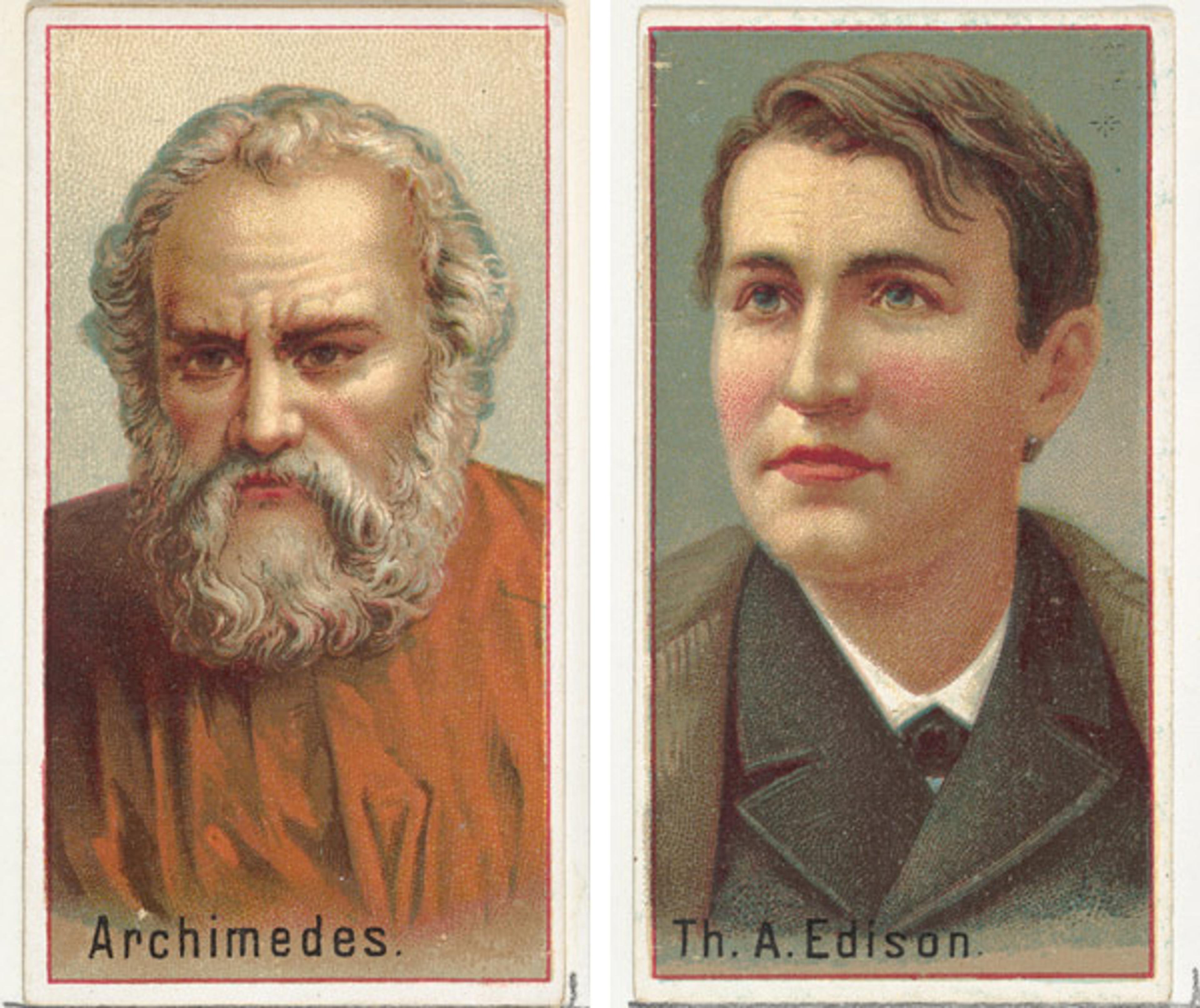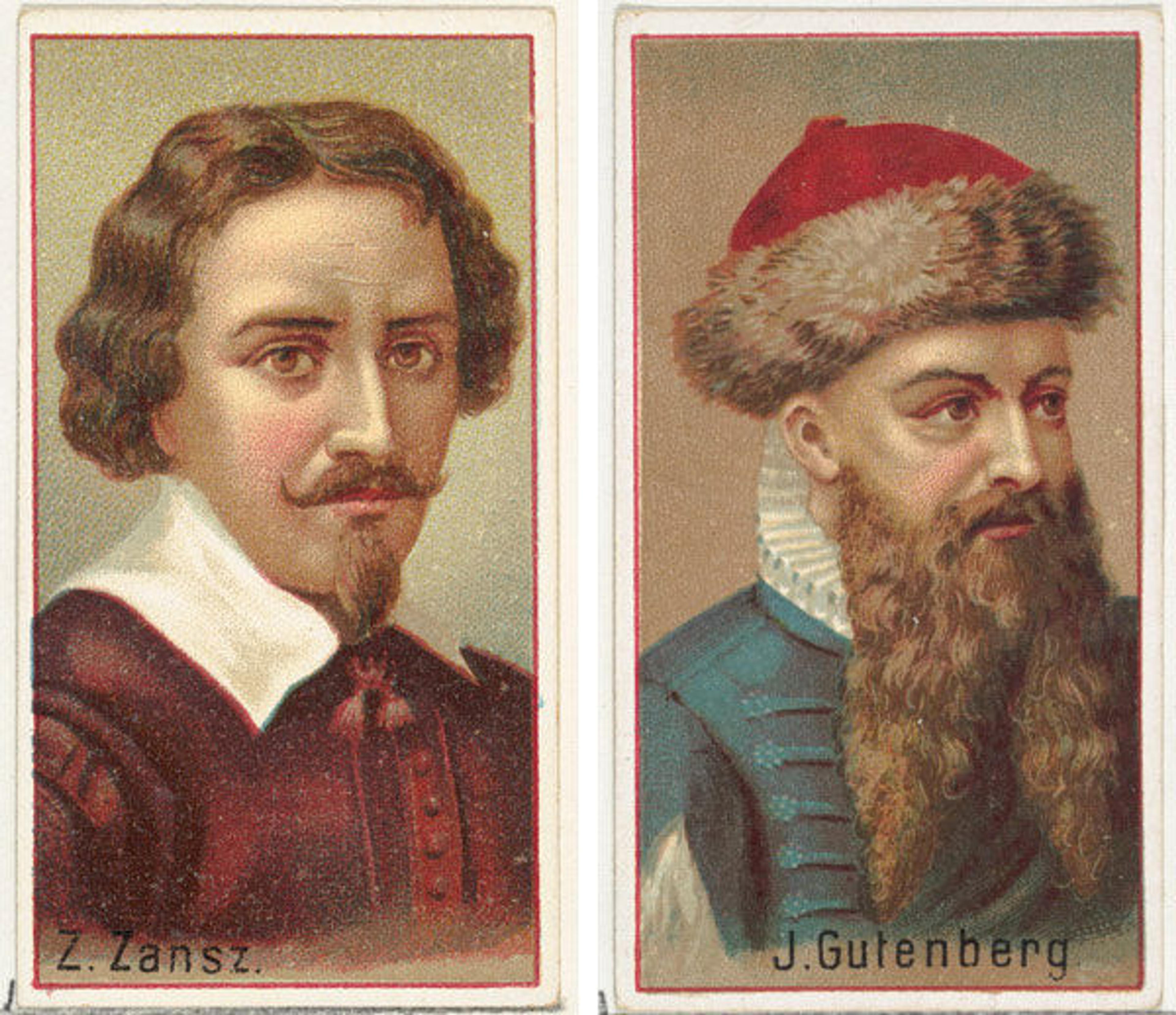
Left: Archimedes, printer's sample for the World's Inventors souvenir album (A25) for Allen & Ginter Cigarettes, 1888. Commercial color lithograph; Sheet: 2 3/4 x 1 1/2 in. (7 x 3.8 cm). The Metropolitan Museum of Art, New York, The Jefferson R. Burdick Collection, Gift of Jefferson R. Burdick (63.350.202.25.1). Right: Thomas A. Edison, printer's sample for the World's Inventors souvenir album (A25) for Allen & Ginter Cigarettes, 1888. Commercial color lithograph; Sheet: 2 3/4 x 1 1/2 in. (7 x 3.8 cm). The Metropolitan Museum of Art, New York, The Jefferson R. Burdick Collection, Gift of Jefferson R. Burdick (63.350.202.25.13)
«The 1880s witnessed an explosion in the production of souvenir cards in the United States. Among the first companies to take advantage of the marketing potential of these collectible cards were tobacco companies such as Allen & Ginter, Duke, and Goodwin, though producers of coffee, chewing gum, and other products also inserted souvenir cards into the packaging of their output.
As printed-ephemera collector Jefferson R. Burdick explained in The American Card Catalogue, published in 1960, collecting souvenir cards became so popular in this decade that tobacco companies issued albums of souvenir cards "intended to replace the individual cards if the smoker so desired, or at least enable him to own the entire collection of designs without the difficulty attendant to obtaining all the individual cards in a set."»
Most of the souvenir albums issued by tobacco companies consisted of loose cardboard sheets, each containing a few cards and bound by a string. Collectors could purchase the albums using coupons found in tobacco packs, with each album costing around seventy-five to one hundred coupons.
The popularity of souvenir albums among card collectors prompted companies to issue a few series exclusively in album form rather than as individual cards. An example is Allen & Ginter's World's Inventors series, issued in 1888. Though only published as an album, Burdick was able to acquire printer's proofs of the series in the form of individual cards.

Left: Z. Zansz, printer's sample for the World's Inventors souvenir album (A25) for Allen & Ginter Cigarettes, 1888. Commercial color lithograph; Sheet: 2 3/4 x 1 1/2 in. (7 x 3.8 cm). The Metropolitan Museum of Art, New York, The Jefferson R. Burdick Collection, Gift of Jefferson R. Burdick (63.350.202.25.48). Right: Johannes Gutenberg, printer's sample for the World's Inventors souvenir album (A25) for Allen & Ginter Cigarettes, 1888. Commercial color lithograph; Sheet: 2 3/4 x 1 1/2 in. (7 x 3.8 cm). The Metropolitan Museum of Art, New York, The Jefferson R. Burdick Collection, Gift of Jefferson R. Burdick (63.350.202.25.21)
The World's Inventors series consists of forty-eight cards, each featuring the portrait of an inventor and printed using a newly developed process of commercial lithography. Burdick arranged the cards in an album alphabetically by inventor name, from Archimedes to Zansz. In addition to occupying the first position within the album sheet, Archimedes—active in the third century B.C.—is among the earliest figures represented. The Greek mathematician invented several machines, including the screw pump and compound pulley. One of the more recent examples of inventors in the series is Thomas Edison, who had begun work on the lightbulb just a decade prior to the publication of the World's Inventors series.
Zansz, better known today as Laurens Janszoon Coster, was a Dutch inventor who purportedly developed a printing press at the same time as his more famous German counterpart, Johannes Gutenberg. Gutenberg is also represented in the World's Inventors series, donning the fur cap that has become a signature of his printed portraits.
Related Links
The Jefferson R. Burdick Collection of Printed Ephemera
Now at the Met: "Celebrating the Jefferson R. Burdick Collection" (September 24, 2015)
